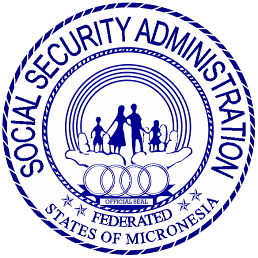Why pay social security taxes?
Employer Identification Numbers (EIN)
The Act defines employees as:
- any officer of a corporation, or
- any individual who, under the usual common law rules applicable in determining the employer-employee relationship, has the status of an employee; or
- any self-employed person who has at least one employee for whom he is required to report in a given quarter; or
- any self-employed person who had more than $10,000 of annual gross revenue in the preceding calendar year.
Employees also include FSM citizens employed in FSM embassies and consulates located outside of the FSM, non-citizens employed on “special contracts” within the FSM, and domestic service.
Employers
- sole proprietors who have at least one employee;
- sole proprietors who have more than $10,000 of annual gross revenue in the preceding calendar year;
- partnerships;
- corporations;
- foreign entities operating or doing business in the FSM under a foreign-aid agreement;
- FSM National and State Governments and all agencies, bodies, or political subdivisions thereof; and
- Foreign investment permit holders, subject to provisions of Social Security self-employment, partnership, or corporation tax filing requirements.
Self-Employment
Self-employed persons who have no employees are required to file the Employer’s Quarterly Tax Return for such quarters indicating their self-employment status and marking the “No Payroll This Quarter” box. At the end of the fourth quarter, these self-employed persons must attach a copy of their Business Gross Revenue form with their Employer Quarterly Tax Return. If gross revenues exceed $10,000, then these self-employed persons must report gross wages for themselves for each calendar quarter equal to 5% of the business’ gross revenues for the calendar year.
To compute for Quarterly Gross Wages:
Example:
- 2013 Business Gross Revenue = $ 16,000 x 0.05
- Quarterly Gross Wages = $ 800
- Quarterly Social Security Tax Due = $800 x 15% = $120.00
- Annual Social Security Tax Due = $120.00 x 4 quarters = $480.00
If a self-employed person only had employees for some quarters during the calendar year, then the self-employed person would report gross wages for himself equal to twice the wages of the highest paid employee for those quarters in which he had employees, and for the remaining quarters would use the preceding formula for self-employed person with no employees.
A self-employed person with more than one business and no outside employment shall report wages for himself for the quarter equal to twice the wages of the highest paid employee from all of the businesses.
A self-employed person with more than one business, each of which does not meet the minimum $10,000 gross revenue rule, may combine any of the businesses until the “over $10,000” gross revenue amount is reached.
 FSM Social Security Administration
FSM Social Security Administration 